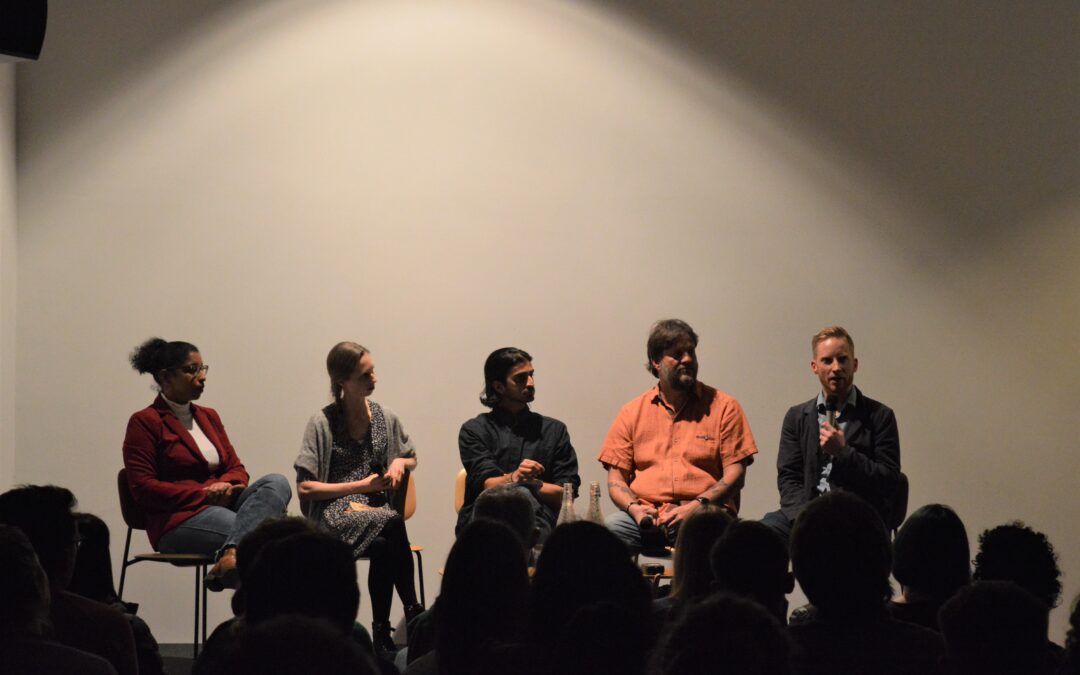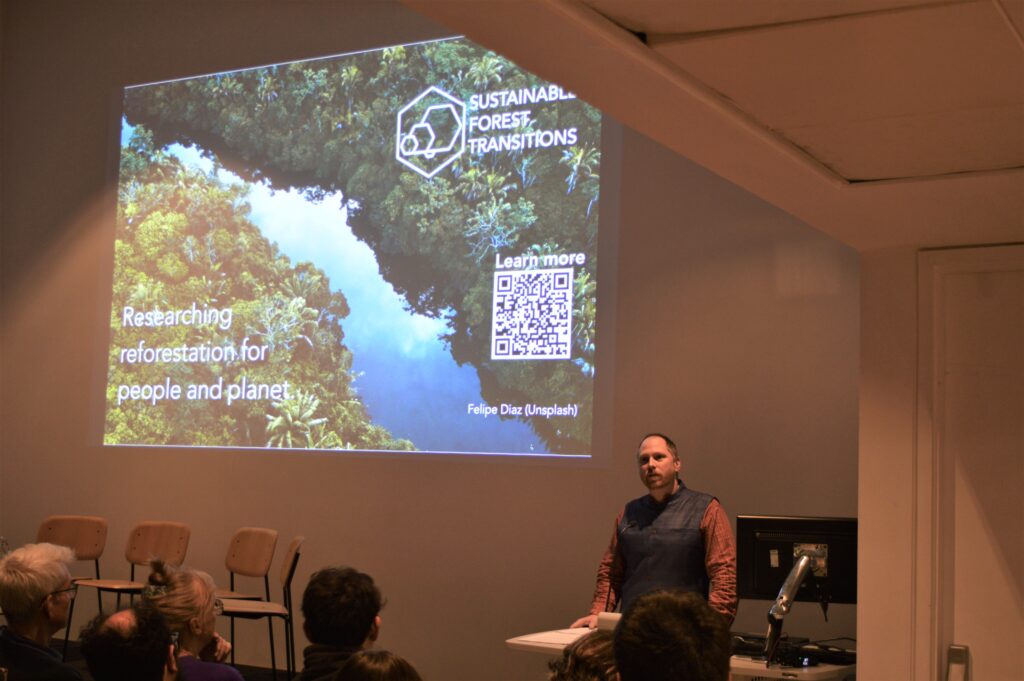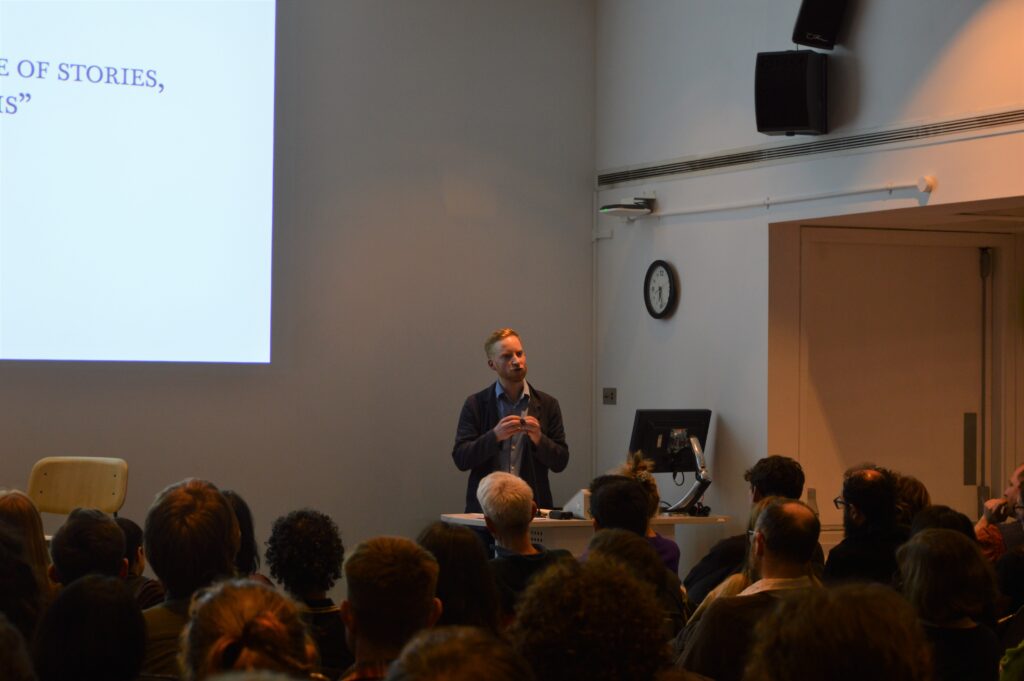On Wednesday 6th March, the Manchester Museum hosted the launch of the Sustainable Forest Transitions research project. Led by Dr Johan Oldekop, Reader in Environment and Development at the GDI, the five-year research programme will study reforestation and what it means for forest communities globally.
The theme of the event centred around the ‘Future of Forests’ and included an address by photographer Kieran Dodds, who gave an artist talk on his work on Church forests in Ethiopia. The talk provided a fascinating insight into the ways that community practices can make meaningful contributions to forest protection, alongside photography featured in his book The Church Forests of Ethiopia.
This talk was followed by a panel discussion between Polyana Bispo, Felipe Melo, Adithya Pradeep, and Rose Pritchard (pictured above) on forests and forest-dependent communities, engaging with topics such as the ethical use of datasets and the role of carbon markets in reforestation.
For further insight into some of the key talking points of the event, we have included the opening remarks given by Dr Oldekop below.
Why Forests? An Introduction by Dr Johan Oldekop
Forests are home to 80% of the world’s plants and animals. They regulate the world’s climate through these incredible atmospheric rivers, which are like huge rivers in the sky that take moisture and dust from one part of the planet to another. The Amazon rainforest, for example, is instrumental in regulating rainfall in North America.
Forests of course also sequester carbon. In fact, forests sequester 16 billion tonnes of carbon per year, which is equivalent to 1 billion double decker buses!
Forests are currently the best technology available to us to remove carbon dioxide from the atmosphere. Restoring forests across the world could help us tackle both the climate and biodiversity, generating habitats for plants and animals and soaking up to 25% of our carbon emissions.
But of course, forests are much, much more than animals, climate, and carbon. They are home to millions of people around the world who depend on them directly for food, fuel, and medicine. It’s therefore not surprising that many of us, in the UK and abroad, have very deep personal connections to forests.
Unfortunately, forests globally are not in very good shape. Forests once covered half of Earth’s landmass, but this has now been reduced to a third as we continue to lose large amounts of land to deforestation and, more recently, to climate change. We have seen unprecedented droughts in the Amazon rainforest last year, for example, which lead to tree death and fires.
What Can Be Done?
There is some good news. Some areas of the world have seen huge increases in tree cover. Chile, Uruguay, India, parts of the Atlantic Rainforest in Brazil, China and other parts of the world have seen large increases in forest cover, and in 2021, Governments, philanthropists, and private organisations from around the world met in Glasgow and pledged to protect and restore forests, committing more than $22 billion dollars to supporting forests and forest communities.
We must ask ourselves:
- What leads to long-lasting increases in forest cover?
- Is it only tree planting initiatives or are there other, more environmentally efficient and just ways? This might include giving land back to Indigenous peoples, for example.
- How different are new forests to old forests? And how are the lives of people being affected by forests that are growing back?
These are really important questions and ones that we will be answering with our new Sustainable Forest Transitions project.
These questions are important because forests and trees are undoubtedly part of our climate and biodiversity solutions toolkit, but also because hundreds of millions of people, mostly Indigenous peoples and local communities that have been often politically and economically disadvantaged, live in areas that have been earmarked for forest restoration. If we want to get reforestation right, we need to get reforestation to work for people on whose land forests are growing back.
We are now in a unique position to answer these important questions about reforestation because we have more data on forests and people than we have ever had.
How is Technology Helping Reforestation Efforts?
Technological advancements in the last 10 years have revolutionized forest monitoring. Satellite-based systems offer real-time data on forest cover, deforestation, and vegetation changes, facilitating accurate health assessments.
Drones equipped with laser technology provide detailed ground-level monitoring, creating high-resolution 3D maps for terrain and tree structure analysis. Artificial intelligence and machine learning automate data analysis from satellites, recognizing patterns and anomalies for early threat detection. These technological strides empower scientists and policymakers and can revolutionise global forest conservation and restoration.
In parallel, technological advances in how information is collected and stored has made it easier for governments and international organisations, like the World Bank, to share data on poverty and human wellbeing. And because we can now pinpoint the location of these data, we can combine them with forest data, giving us the opportunity to measure changes in forest cover and poverty and human wellbeing in parallel over very large areas. It is these advances in data that make our Sustainable Forest Transitions programme feasible.
Looking to the Future
It’s very easy to feel despair about the state of the world, but we have more tools available to us than ever before, to both understand the world and also to change it.
We scientists can observe the world and make recommendations to governments and decision-makers. Making real, long-lasting change for people and the planet will require governments, communities, and the private sector to work together. That is my vision and my hope for the future of forests.
Finally, I’d like to quote or paraphrase Hannah Ritchie from the University of Oxford who has just published a book called “Not the End of the World”. In it she says: “We can be the first generation to create a sustainable world”.
You can read more about the Sustainable Forest Transitions project here.
Note: This article gives the views of the author/academic featured and does not represent the views of the Global Development Institute as a whole.
Please feel free to use this post under the following Creative Commons license: Attribution-NonCommercial-NoDerivatives 4.0 International (CC BY-NC-ND 4.0). Full information is available here



